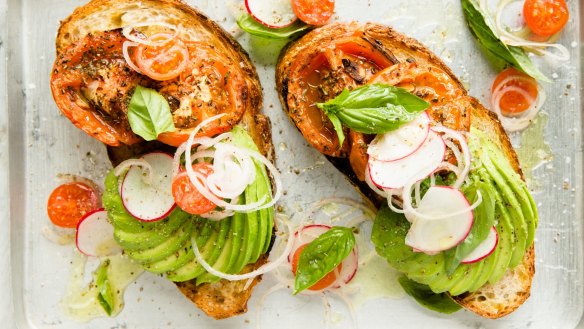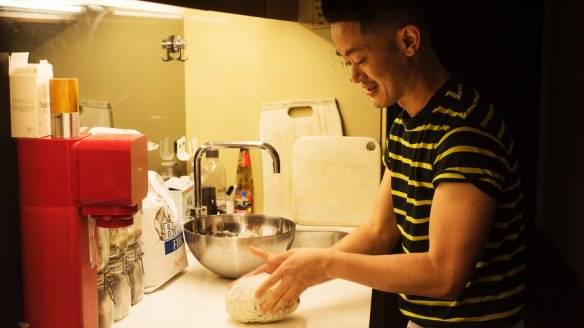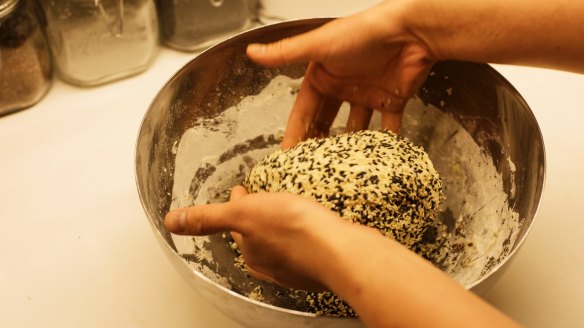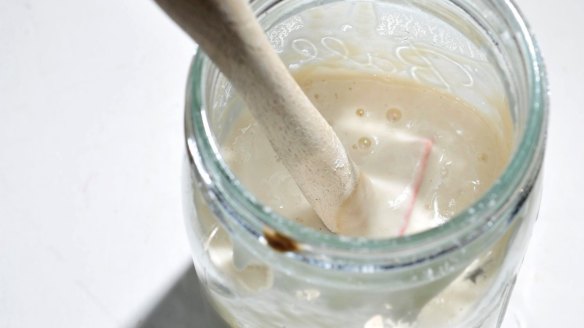Benjamin Law's quest for the perfect sourdough bread

If you grew up Christian or, like me, attended a Christian school for 12 years, you'd know there's a lot of bread in the Bible. Bread represents the body of Christ, bread is mentioned in the Lord's Prayer and Jesus, a man of excellent culinary taste, was all about piping hot loaves paired with seafood. (If you're coeliac or gluten-intolerant, let's say your relationship with God might be complicated.) Early morning devotion services were supposed to make us think of God, but mostly they just made me think about bread. God, I love bread.
Nowadays, while most Australians focus on the avocado aspect of our national avocado-and-toast obsession, we've seemingly forgotten bread – decent bread, at least – is pretty bloody expensive too. If you prefer chewy sourdough, a decent loaf will cost you anywhere upwards of seven or eight bucks. When I moved near a good bakery a few years ago, I'd wait – rodent-like – until the afternoon to get them on special, when I knew they were about to chuck the loaves into the bin. (Or maybe they were about to give them to the homeless or something; look I didn't say I was proud of myself.)

However, any smart-shopper will notice grocery stores sell massive, multi-kilo bags of decent-grade flour for the same price as a single loaf of bread. And considering the gross miracle of sourdough is that all you need is simply salt, water and flour and mixing it together until it reeks, shouldn't we all be making the stuff at home ourselves?
So a couple of years ago, my folks enrolled me in a sourdough baking workshop. It was very informative, but also kind of intense. Every participant at one stage had a harrowed look that screamed, "IS THIS MEANT TO BE THIS DIFFICULT?". Egos were destroyed. Self-esteems were shattered. I left the several-hour long lesson slightly ashen. Single loaves, we also all learned, took hours – technically days – to prepare and make. Who has that kind of time?
Afterwards, I just assumed I wouldn't even attempt making bread. It was too involved, too fiddly, too time-consuming. But diabolically, the dude who ran the workshop gave us all a small sourdough starter, a living glob of flour and fart-filled yeast that would die unless we fed it regularly. Even though it smelled like balls, I felt guilty about murdering the thing. After a few days of feeding this slimy beast, I figured I'd may as well attempt making a loaf. During my first attempt, I burned myself. The loaf came out looking like a dropped organ. It tasted like baked Clag. My boyfriend probably questioned why I was putting myself – and, more importantly, him – through all this.
People seem to love bread even more than muscled nudity.
What makes sourdough difficult is its unpredictability. Not to cast aspersions and judgments on wild yeast or anything, but it's an unstable ingredient. If you get the timing, temperature or consistency wrong, you'll find your hands smeared with napalm-like glug, and trying to get it off your hands will render you into the bakery version of Lady Macbeth. My next few loaves were passable, but really dense – edible, but with none of those lovely stretched holes for melted butter to messily drip through. Another time, I forgot to feed my starter and it started weeping (literally) and nearly turned grey. Eventually, I got one perfect loaf … until I realised I'd forgotten the salt. Turns out bread is disgusting without it.
Eventually though, you discover that learning to bake sourdough is sort of like learning to drive a manual car. When you start, it's the most unnatural thing in the world (what is a clutch and why?), but after a while, it becomes instinctive and second-nature. Baking sourdough's the same: you start intuitively knowing when the starter's happy (answer: when it smells and looks like a yeast infection, because that's basically what it is), what time of day to do each step, and what equipment's best at preventing a royal mess.
My first successful loaf was spectacular: golden crust, chewy crumb and looked bakery-perfect. But it was also the result of a months of experimentation, and realising you can't cheat the starter. When they say feed it every day, you really do have to feed it every day. My reward hasn't just been excellent bread and a boyfriend who loves me at least 10 per cent more, but enormously smug Instagram posts. (People seem to love bread even more than muscled nudity – this gives me hope somehow.)
And once you have the technique nailed, it's something that will restructure your life – in a good way. I work from home, so baking bread punctuates my work schedule now. Yes, the process is time-consuming, but the actual labour required is close to nil.
Nowadays, I legitimately question what was more valuable: seven years of expensive tertiary education, or that random sourdough class I did that one time. At the very least, one cost me a lot of money, and the other one's saved me a bundle. Here's what you need to do the same.

Equipment
Cast-iron Dutch oven
Kitchen scales
Big-arsed bowl
Small bowl or Pyrex jug
Ingredients
Decent quality unbleached flour
Water
Salt
Seeds (optional) – poppy, sesame, linseed, pumpkin, sunflower are great
Starter
Day 1: Combine the same weight (not volume) of water and flour – about 80 grams. The consistency will be similar to a thick, gluggy batter. Chuck in three sultanas or some currants. Cover with a damp cloth and keep overnight at room temperature.
Day 2: Next day, some small bubbles should have formed. Discard 90 per cent of the batter and the dried fruit. "Feed" your starter again with flour and water mixture.
Day 3, 4, 5 and 6: Repeat above.
Day 7: After a week, your starter will be growing bigger and faster with each feed, like something from Ghostbusters. It'll have started to smell … well, sour. Visually, it'll resemble something vaguely medical that belongs on Embarrassing Bodies. Congratulations. You have a starter! You have a new pet! (Mine's named Horace!) You will start to lose friends!

Bread
1. Feed the starter the night before baking. You want that bastard angry and bubbly by morning.
2. At breakfast time, mix 200 grams of warmish water with 200 grams of starter. (You'll know the starter is happy and healthy because it'll float on the water like it's on holiday.) Let the mixture sit so any weird lumps can dissolve.
3. Add 360 grams of flour. Mix with a dessert spoon and don't worry too much about texture. Walk away for an hour.
4. Wet your clean hand (this makes it glug-proof, as well as adding moisture to the mix) and mix everything together more thoroughly. Start from the outside of the bowl and work the corners inwards. The mixture will go from looking choppy to glossy and smooth. Walk away for an hour.
5. Mix with wettened hand. Walk away for an hour.
6. Mix with wettened hand. Walk away for an hour.
7. Mix with wettened— you know the drill. Also, the phrase "wettened hand" is starting to make me nauseous.
8. In the afternoon, chuck in 10 grams of good quality salt. This will seem like a lot, but that's bread for you. Mix with your soggy mitts again.
9. Add seeds. Or don't! Personally, I love seedy bread and chuck in a small handful of linseeds, poppy seeds, pumpkin seeds and sunflower seeds. If you do this, I promise you'll never be constipated again. Mix with your moistened paws.
10. Stretch that dough! Plonk your dough on a large clean surface, put your hands in a upside-down V steeple formation at the top of the dough, then drag the dough towards you. If the consistency is right, the dough will fold in on itself like a wheel. This is my favourite part of the process.
11. Thoroughly coat dough with seeds, flour and/or semolina. This prevents the bread from sticking to the Dutch oven later. I basically cover mine in black and white sesame seeds with a bit of semolina. You can skip the seeds and use plain flour or semolina, whatever you like.
12. Put it in a colander or sourdough proofing basket, cover with a damp tea towel and chuck it in the fridge.
13. At the end of the evening bake the bread. Dust the bottom of the Dutch oven with semolina to make it non-stick and blast it in a 250C oven for 15 minutes. It will become hotter than hell, so be careful: use thick oven mitts or super-thick tea towels, and slowly take the super-hot Dutch oven out. Tip the dough onto a chopping board and quickly slash the top with either a kitchen razor or serrated bread knife. The faster, the better. Pop the dough inside the Dutch oven with the lid on and bake for 25 minutes.
14. After 25 minutes, carefully take off the lid. Bake for another 25 minutes.
15. Congratulations. You have a lovely round sourdough loaf. Your house smells like bread! Your entire neighbourhood envies and resents you! And you have completed boss-level home baking.

Tips
Experiment. This method works for me, but I only got there through trial and error. Every home bread baker has similarly played with their technique until it works just right for them.
Feed your starter every day. Chuck it in the fridge if you know you're going to skip a day, but don't let it die in there. If you stop feeding it for several days, it'll start sweating fluid, which means it's dying. The more regularly you feed it, the bubblier and more active it'll get. A flat, unenthusiastic starter means flatter, denser bread.
If you're going on holidays, dry your starter. Smear a decent glob of healthy starter on baking paper, let it dry for 24 hours and store the dried, smelly crust in an airtight container. Reanimate it with water and feed when you get back.
Don't throw out stale sourdough! That crusty hard-as-cement bread is perfect for making sippets (big-arsed croutons) for salads and soups. Chop into rough cubes, coat with olive oil, salt and pepper (thyme is good too) and either fry or roast on medium heat until golden-brown and crunchy. It's the best. If they're super crunchy, they'll last in airtight containers too.
Benjamin Law is a columnist for Good Weekend and is the creator and co-writer of the comedy The Family Law (SBS On Demand).
Appears in these collections
The best recipes from Australia's leading chefs straight to your inbox.
Sign upFrom our partners
Original URL: https://www.theage.com.au/goodfood/tips-and-advice/benjamin-laws-quest-for-the-perfect-sourdough-bread-20170818-gxzedu.html